Are you consistently riddled with pain in calf when walking or do you wake up due to leg cramping or aching pains? If so, you may be experiencing one of the more common of vascular disease, peripheral arterial disease. Your body’s vascular system is a network of blood vessels that include your capillaries, veins, and arteries that transport the blood to and from your heart. Problems that occur within a person’s vascular system can be quite serious while also being very common.
What Is A Vascular Disease?
By definition, vascular disease is a condition that is abnormal within the blood vessels. It is a condition that is primarily caused by atherosclerosis, which is the hardening of the arteries. The hardening usually begins with a thickening of the lining of the arteries from plaques or fatty deposits. Given that the arteries are responsible for the transport of blood to and from the heart, hardened and narrowed arteries make this increasingly difficult. The parts of the body that become the most affected by this disease suffer from tissue damage, reduced functionality, as well as an inadequate supply of blood. In the worst cases, the tissue that does not receive a proper amount of blood supply will simply die. As a person ages, they become more likely to suffer from a form of vascular disease. Additional factors that have been known to contribute to the onset of vascular disease include:
- A family history of heart or vascular disease
- Pregnancy
- Injury or illness
- Extended periods of time spent either standing still or sitting
- Conditions that affect the blood vessels or the heart such as high cholesterol or diabetes
- Smoking
- Obesity
10 Common Vascular Diseases
Approximately 1 out of every 2 people in their lifetime will suffer from vascular disease. As the rates of Type II diabetes and obesity increase and the population becomes older within the United States, it has been estimated that, by 2024, more than two million will die each year from thiskind of diseases. Here we list 10 most common vascular diseases that one should pay attention to.
1. Peripheral Artery Disease
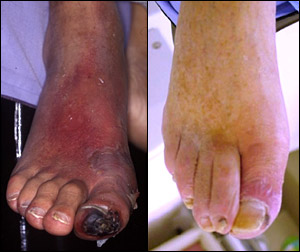 Simply stated, peripheral artery disease (PAD) is an issue where narrowed arteries decrease the amount of blood flow to a person’s limbs. Once PAD has happened, patients' extremities, most often the legs, do not get the amount of blood needed to fulfill the demand. This will result in symptoms including intermittent claudication (leg pain while walking). Generally, this can be successfully treated through exercise, the incorporation of healthy diet, as well as the removal of tobacco.
Simply stated, peripheral artery disease (PAD) is an issue where narrowed arteries decrease the amount of blood flow to a person’s limbs. Once PAD has happened, patients' extremities, most often the legs, do not get the amount of blood needed to fulfill the demand. This will result in symptoms including intermittent claudication (leg pain while walking). Generally, this can be successfully treated through exercise, the incorporation of healthy diet, as well as the removal of tobacco.
2. Aneurysm
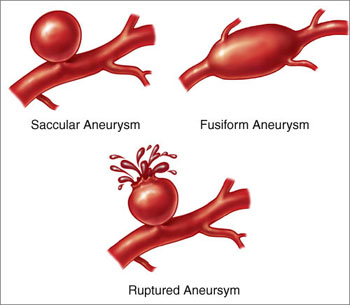 An aneurysm is the ballooning or a bulge that is found within the wall of an artery. Most tend to occur with the main artery that runs from the heart to the abdomen and the chest. Some can occur within the arteries of the heart, and brain, as well as a variety of body parts. Should one burst in the brain, it will result in a stroke. Aneurysm is able to develop and becomes quite large before presenting any symptoms. Most often their detection is by chance as a person is undergoing testing for other conditions. The two main forms of treatment for an aneurysm are surgery and medicines.
An aneurysm is the ballooning or a bulge that is found within the wall of an artery. Most tend to occur with the main artery that runs from the heart to the abdomen and the chest. Some can occur within the arteries of the heart, and brain, as well as a variety of body parts. Should one burst in the brain, it will result in a stroke. Aneurysm is able to develop and becomes quite large before presenting any symptoms. Most often their detection is by chance as a person is undergoing testing for other conditions. The two main forms of treatment for an aneurysm are surgery and medicines.
3. Renal (Kidney) Artery Disease
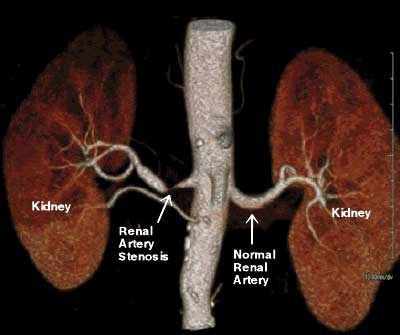 This disease is caused by a buildup of plague within the arteries that lead towards the kidneys. Plague consists of cholesterol and fats that are able to accumulate in the renal arteries, causing them to narrow and stiffen. Once this occurs, blood flow is blocked to the kidneys, which results in renal artery stenosis that causes kidney failure, congestive heart failure, and poorly controlled high blood pressure.
This disease is caused by a buildup of plague within the arteries that lead towards the kidneys. Plague consists of cholesterol and fats that are able to accumulate in the renal arteries, causing them to narrow and stiffen. Once this occurs, blood flow is blocked to the kidneys, which results in renal artery stenosis that causes kidney failure, congestive heart failure, and poorly controlled high blood pressure.
4. Raynaud's Phenomenon
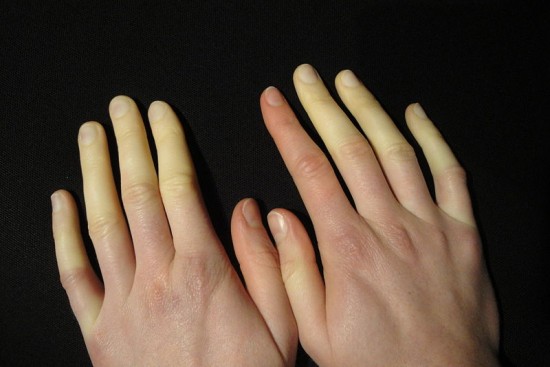 Raynaud’s phenomenon causes areas of your body, such as toes and fingers, to become numb and cold as a response to stress and cold temperatures. With this disease, the smaller arteries that supply blood begin to narrow, limiting the circulation of blood to the affected areas. The treatments of the disease are in dependent upon its severity within a person as well as if there are additional health issues present. For the vast majority of sufferers, the disease is not disabling, but it will alter their quality of life.
Raynaud’s phenomenon causes areas of your body, such as toes and fingers, to become numb and cold as a response to stress and cold temperatures. With this disease, the smaller arteries that supply blood begin to narrow, limiting the circulation of blood to the affected areas. The treatments of the disease are in dependent upon its severity within a person as well as if there are additional health issues present. For the vast majority of sufferers, the disease is not disabling, but it will alter their quality of life.
5. Buerger's Disease
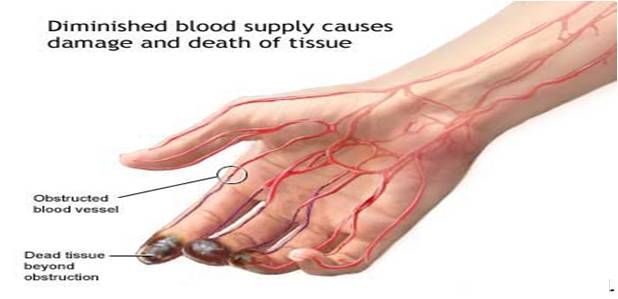 Most commonly, Buerger’s disease will affect arteries, nerves and veins that are small and medium sized. The cause of this disease is currently unknown, but there is a strong association between it and a person’s exposure to or use of tobacco. The arteries within the legs and arms become either blocked or narrowed, resulting in a lack of blood flow and supply to the feet, toes, hands and fingers. Even with rest, a great deal of pain is incurred frequently within the affected areas.
Most commonly, Buerger’s disease will affect arteries, nerves and veins that are small and medium sized. The cause of this disease is currently unknown, but there is a strong association between it and a person’s exposure to or use of tobacco. The arteries within the legs and arms become either blocked or narrowed, resulting in a lack of blood flow and supply to the feet, toes, hands and fingers. Even with rest, a great deal of pain is incurred frequently within the affected areas.
6. Peripheral Venous Disease
 Peripheral venous disease is a term describing damage, defects or blockage in the veins whichtransfer blood from the hands and feet to the heart. Peripheral venous disease can happen to almost anywhere in the body but is mostly seen in the arms and legs. The most common cause of peripheral venous disease is a blood clot that blocks a vein. A clot forms when vein walls become weak and blood flow slows. When the clot is in a vein deep within the body, it is called deep vein thrombosis. When the clot is in a vein closer to the skin, it is called superficial thrombophlebitis.
Peripheral venous disease is a term describing damage, defects or blockage in the veins whichtransfer blood from the hands and feet to the heart. Peripheral venous disease can happen to almost anywhere in the body but is mostly seen in the arms and legs. The most common cause of peripheral venous disease is a blood clot that blocks a vein. A clot forms when vein walls become weak and blood flow slows. When the clot is in a vein deep within the body, it is called deep vein thrombosis. When the clot is in a vein closer to the skin, it is called superficial thrombophlebitis.
7. Varicose Veins
 Varicose veins are expanded, puffy, ropy, purple veins, seen just under your skin. It usually caused by damaged valves within the veins. These affect women more often than men and frequently present as a medical family history. They are also attributed to severely overweight,pregnancy, or standing for long time. The signs and symptoms of varicose veins include but aren’t limited to spider veins, painful or swelling of the legs, etc.
Varicose veins are expanded, puffy, ropy, purple veins, seen just under your skin. It usually caused by damaged valves within the veins. These affect women more often than men and frequently present as a medical family history. They are also attributed to severely overweight,pregnancy, or standing for long time. The signs and symptoms of varicose veins include but aren’t limited to spider veins, painful or swelling of the legs, etc.
8. Blood Clots in the Veins
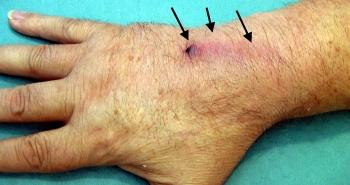 There are many types of blood clots that can occur in the veins like deep vein thrombosis and pulmonary embolism. It can be caused by many factors like long bed rest, immobility, conditions involving thicker blood or slowed blood flow, hormones and pregnancy, congestive heart failure (CHF), certain tumors and so on. Different treatments will be applied for different blood clots conditions.
There are many types of blood clots that can occur in the veins like deep vein thrombosis and pulmonary embolism. It can be caused by many factors like long bed rest, immobility, conditions involving thicker blood or slowed blood flow, hormones and pregnancy, congestive heart failure (CHF), certain tumors and so on. Different treatments will be applied for different blood clots conditions.
9. Blood Clotting Disorders
 Blood clotting disorders occur when the blood is more likely than normal to clot in the arteries and veins. Basically, such kinds of disorders may be hereditaryor acquired throughout one’s life and the signs include:
Blood clotting disorders occur when the blood is more likely than normal to clot in the arteries and veins. Basically, such kinds of disorders may be hereditaryor acquired throughout one’s life and the signs include:
- High levels in the blood of certain components like factor 8, fibrinogen and prothrombin which cause blood to clot.
- Higher than normal blood counts.
- Deficiency of natural anticoagulant proteins like antithrombin, protein C and protein S.
- Abnormal changes inthe blood vessels linings.
- Abnormal fibrinolysis or the breakdown of fibrin.
10. Lymphedema
 Lymphedema refers to swelling that generally occurs in one of your arms or legs, sometimes both arms and both legs swell. Lymphedema is most commonly caused by cancer treatments which require the removal or damage of your lymph nodes, which may result in a blockage in the lymphatic system. The blockage prevents lymph fluid from draining well, leading to swelling. There's no cure for lymphedema. So early diagnosis and diligent care of your affected limb is important.
Lymphedema refers to swelling that generally occurs in one of your arms or legs, sometimes both arms and both legs swell. Lymphedema is most commonly caused by cancer treatments which require the removal or damage of your lymph nodes, which may result in a blockage in the lymphatic system. The blockage prevents lymph fluid from draining well, leading to swelling. There's no cure for lymphedema. So early diagnosis and diligent care of your affected limb is important.